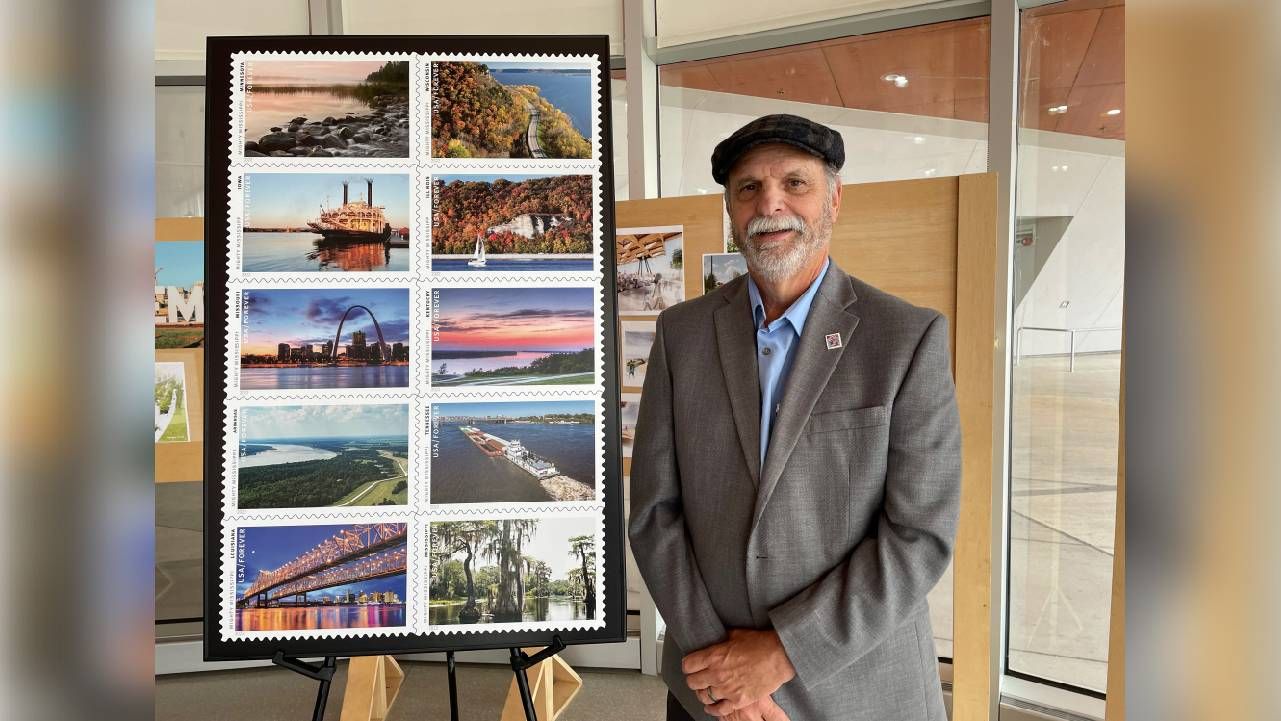How a Retiree’s Photograph Wound Up on a Postage Stamp
A Navy veteran and former chemist transformed a long-time interest in photography into an artistic legacy
When Larry Braun was wondering what to do in retirement, the chemist had no idea that reviving the photography hobby of his youth would lead to a featured U.S. postage stamp. Braun's photo of sunset over the Mississippi River at Kentucky was one of 10 stamps the United States Postal Service released this spring as the "Mighty Mississippi" collection.

"This stamp thing has really been a boost to my photography," Braun says. "It has exposed my work to a larger audience and gives it more credibility. People say, 'he's the guy who did the stamp'."
At age 69, Braun says he unconsciously evolved from shooting solely for pleasure to becoming a professional photographer. In 2008, he placed first in a photo contest at the Margaret Harwell Museum in Poplar Bluff, Missouri. That gave him confidence. Since then, he's exhibited his work at other venues in Southeast Missouri, Southern Illinois and Western Kentucky and won multiple regional awards.
"It has exposed my work to a larger audience and gives it more credibility. People say, 'he's the guy who did the stamp.'"
In addition, one of his Mississippi River photos was published in "Architectural Digest." Three were selected for Missouri Life magazine's "My Missouri" photo project to celebrate the bicentennial of statehood. They are now part of the Missouri Historical Society's permanent collection.
A Passion for Making Art Out of the Ordinary
Braun has been commissioned to create books of towns and farms and produced two books of his own, "Towns of Southeast Missouri: A Photo Tour" and "Christmas Country Church Tour." Braun's photographs hang in regional hospitals, clinics, hotels and banks. "I like doing work for hospitals," he says. "It's part of the healing process having these pictures there."
Being retired, Braun says he doesn't have to earn a living with his camera, so he shoots only what interests him — landscapes, old buildings and Midwestern and Southern small towns — like his own, Benton, Missouri. He's passionate about "making art from the ordinary" and evoking mood.
"There's a lot of things here people don't look at," he says of the rural regions he travels. "They're ordinary things. But when you look at them a certain way, there's a mystic or spiritual part that I'm trying to capture. Without feeling, it's just a snapshot that anyone could take. The feeling is how I put my own stamp on it."
It was while serving on the aircraft carrier USS Midway in the 1970s that Braun bought his first camera. Wanting to record his travels, as his father had done as a service member during World War II, Braun took pictures of street scenes in Singapore, Japan, the Philippines, Korea and Hong Kong. But when his military service ended, his photographing tapered off.
"I wanted to go into photography in college but I didn't think I could make a living with it," says Braun. Instead, he majored in chemistry at Southeast Missouri State University, then worked for the New Madrid Power Plant for 34 years.
"To capture feeling, you've got to have time to sit and think and feel."
With his children grown and retirement looming, Braun began hiking for health and enjoyment. He joined a hiking group in St. Louis that he found online. They met at trailheads around the state. To document his hikes, Braun bought a small point and shoot camera.
Eventually though, he found himself wanting to spend more time alone on the trails with his camera. "People don't want to stop and wait for you to get the right shot," he says. "But to capture feeling, you've got to have time to sit and think and feel."
Getting Serious About His Art
Soon, Braun bought a digital camera and began hiking specifically to take pictures. To improve his skill, he completed a professional photography course online, watched YouTube videos, and did all the exercises in a second-hand photography textbook. Even so, he had difficulty conveying the feel of the places through his photos.
Then he found digital editing software. "Photoshop really lit me up," he said. With the ability to add layers and textures to his shots, he could make them more emotionally expressive. They could look like a painting. "It took me about six months to learn the camera mechanics, but I'm still learning ways to capture feeling visually."
Living within easy driving distance of four states, day trips fuel Braun's work. "I've been on just about all of the hiking trails in Southeast Missouri and Southern Illinois," he says. He's traveled many of the regions' two-lane black-top roads, too. Sometimes he parks and walks along the roadside. "Walking down a country road you'll see things you wouldn't see driving. Walking is good inspiration," Braun claims.
Often those country roads lead to tiny towns whose population and economy have dwindled. Photographing them, Braun points to realist painter Edward Hopper as inspiration—especially his work "House by the Railroad." That painting, Braun says, reflects "how people who do the work feel alienated from the system. I feel drawn to that."
As a fifth generation native of such towns, he tries to show what's unique about them and "put them in their best light." Sometimes that means digging into the history of the place or a specific building he's photographing. He has created an extensive photo collection of the historic French colonial structures of Ste. Genevieve, the oldest permanent European settlement west of the Mississippi. The town itself is a National Historic Park.
In the spring, Braun was photographing towns and trails along Highway 63 from Arkansas to the Iowa border. He has hit pause on shooting until fall. When the summer weather gets hot and humid with thick spider webs crisscrossing the trails, hiking isn't fun so he spends the season processing his photos.
How the Postage Stamp Happened
One of those day trips yielded Braun's postage stamp picture. Returning home just as the sun was fading, he steered into Fort Jefferson Hill Park in Wickliffe, Kentucky, and caught a pastel sky hugging the bend in the river just south of where the Ohio flows into the Mississippi.
That was in 2014. Six years later, the graphic design company scouting for photos for the United States Postal Services' Mighty Mississippi collection found his Kentucky sunset picture on Flickr. They were searching for images from all 10 states the river touches. When they contacted Braun to ask about using his photo, he was excited and honored.
"I feel very connected to the river," he says. "It's a national treasure. Go watch when it's about at flood stage before they close the flood gates. You'll see huge trees floating down the river. And it's a historic river. Mark Twain wrote about it. LaSalle and Lewis and Clark explored it."
On May 23, Braun and his wife, Darcy, day tripped to Memphis, Tennessee, to attend the stamp collection's unveiling ceremony at the Beale Street Landing. As icing on the cake, the unveiling date was also the couple's thirteenth anniversary and his granddaughter Claire's ninth birthday.
"That's Claire," he said, pointing at her photo on his living room wall. "There's a little bit of legacy in this, too. My grandkids and great-grandkids can say their grandfather had a photo on a postage stamp. Not many people do."
Editor’s note: You can see Braun's photography through his website or at the Anna Arts Center exhibit in Anna, Illinois, from July 19 through August 11.


